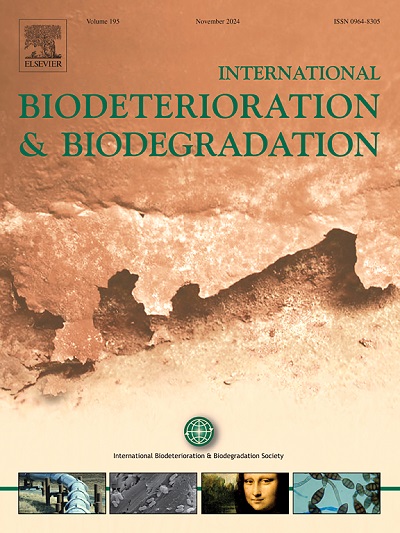硝酸盐/亚硝酸盐与硝酸盐还原菌耦合控制高温油藏硫酸盐还原微生物及腐蚀速率的新策略
IF 4.1
2区 环境科学与生态学
Q2 BIOTECHNOLOGY & APPLIED MICROBIOLOGY
International Biodeterioration & Biodegradation
Pub Date : 2025-03-15
DOI:10.1016/j.ibiod.2025.106065
引用次数: 0
摘要
不同水淹油藏形成不同组成的硫酸盐还原微生物(SRM),关键SRM的活动可能涉及不同的代谢、腐蚀和抑制机制。然而,目前各种油藏中SRM生物抑制方法复杂多变,缺乏适用于现场应用的通用、系统的模型方法。以江苏油田生产水中的SRM为研究对象,研究了抑制剂和硝酸还原菌(NRB)对SRM的有效抑制作用。不同浓度的选择性无机抑制剂实验表明,硝酸盐和亚硝酸盐对SRM群落(JS)的抑制作用显著,其中硫化物的抑制率为49.0% ~ 62.5%,其次是钼酸盐和钨酸盐。以江苏油田生产水中的关键SRM (Archaeoglobus)为研究对象,评价了硝酸盐/亚硝酸盐和3种NRB菌株的抑菌效果。含硝酸盐处理与NRB种类的关系更大,而含亚硝酸盐处理与亚硝酸盐浓度的关系更大。相比之下,含亚硝酸盐处理的硫化物抑制作用更为显著,对酶含量(Apr和Dsr)有明显影响。得到两种最佳抑制组合:硝酸盐(10 mmol/L)和ZW3;亚硝酸盐(5 mmol/L)和ZW3。它们已应用于SRM社区(JS)进行有效性评估,在控制硫化物产量和腐蚀速率方面具有优异的性能。提出了一种硝酸盐介导的储层SRM生物抑制模型方法。这些结果为油田微生物抑制SRM和腐蚀控制提供了见解和策略。本文章由计算机程序翻译,如有差异,请以英文原文为准。

A new control strategy of sulfate-reducing microorganisms and corrosion rate from a high-temperature oil reservoir by nitrate/nitrite coupling with nitrate-reducing bacteria
Different water-flooded oil reservoirs shape diverse compositions of sulfate-reducing microorganisms (SRM), and the activities of key SRM may involve different metabolic, corrosion and inhibition mechanisms. However, the current bioinhibition methods for SRM in various petroleum reservoirs are complex and variable, and universal and systematic model methods are lacking for field application. In the present study, the effective inhibition of SRM from the production water of the Jiangsu Oilfield was investigated using inhibitors and nitrate-reducing bacteria (NRB). The experiments, involving different concentrations of selective inorganic inhibitors, showed that nitrate and nitrite exhibited prominent inhibitory effects on the SRM community (JS) with sulfide reduction by 49.0%–62.5%, followed by molybdate and tungstate. With the target of the key SRM (Archaeoglobus) in the production water of the Jiangsu Oilfield, nitrate/nitrite and three NRB strains were evaluated for their inhibition performance. The nitrate-containing treatments were more related to the NRB species, whereas the nitrite-containing treatments were more related to nitrite concentrations. Comparatively, the sulfide inhibition of the nitrite-containing treatments was more significant, with an obvious influence on enzyme contents (Apr and Dsr). Two preferred inhibition combinations were obtained: nitrate (10 mmol/L) and ZW3; nitrite (5 mmol/L) and ZW3. They have been applied in the SRM community (JS) for effectiveness evaluation, with excellent performance in the control of sulfide production and corrosion rate. A nitrate-mediated model method for the bioinhibition of SRM in oil reservoirs is proposed. These results provide insights and strategies for microbial inhibition of SRM and corrosion control in oilfields.
求助全文
通过发布文献求助,成功后即可免费获取论文全文。
去求助
来源期刊
CiteScore
9.60
自引率
10.40%
发文量
107
审稿时长
21 days
期刊介绍:
International Biodeterioration and Biodegradation publishes original research papers and reviews on the biological causes of deterioration or degradation.

 求助内容:
求助内容: 应助结果提醒方式:
应助结果提醒方式:


